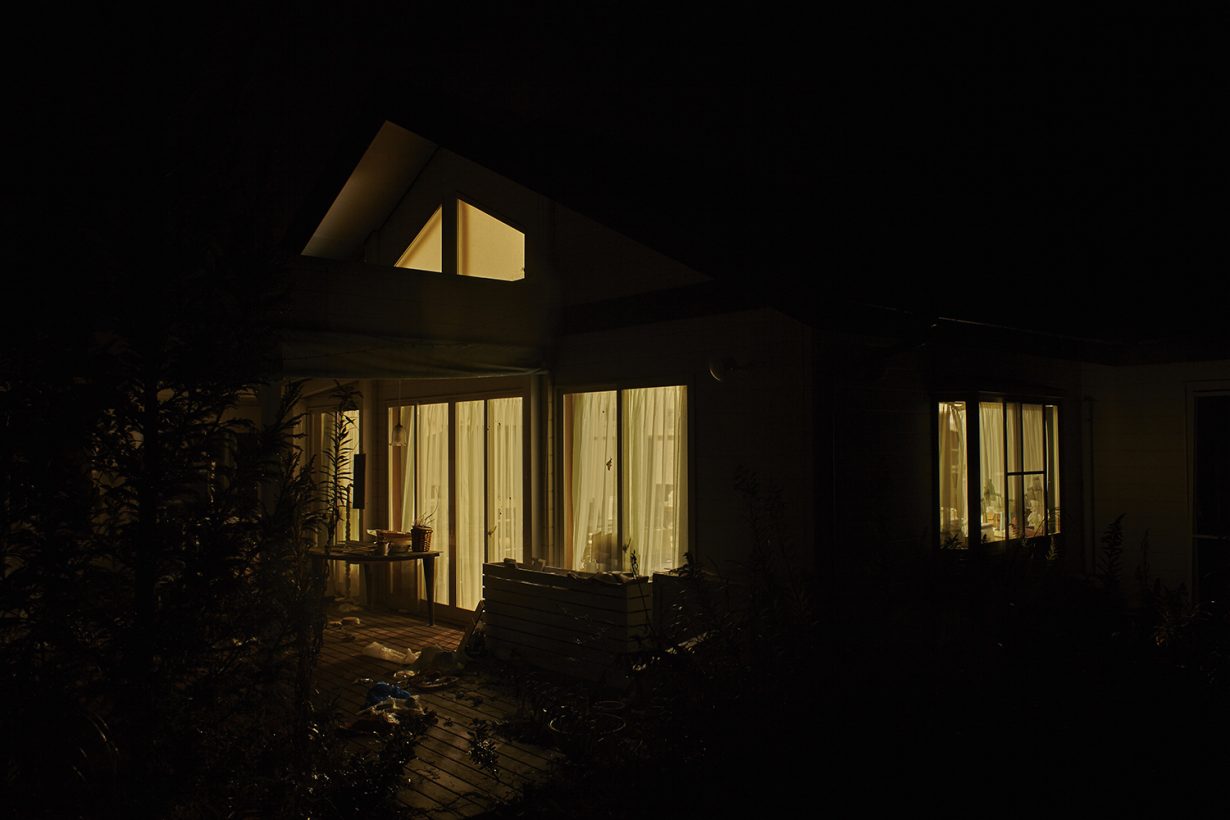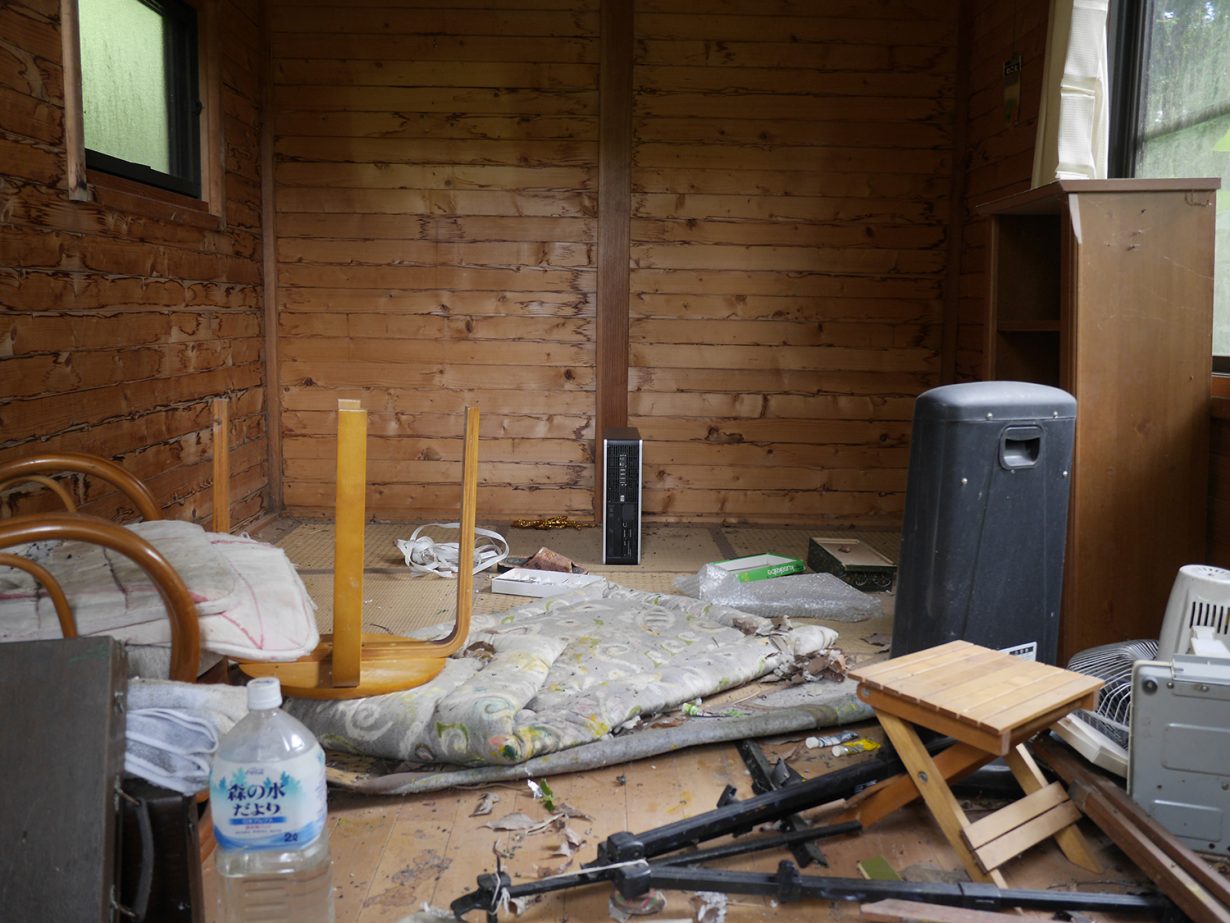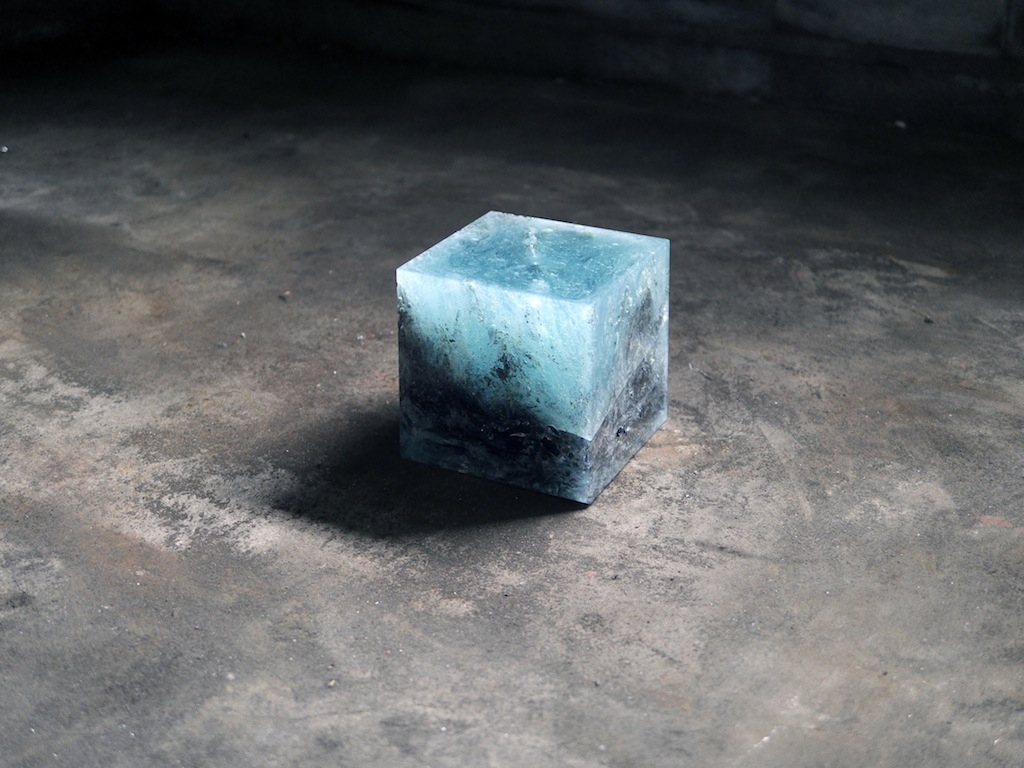An inaccessible exhibition made in response to the 2011 nuclear disaster, initiated by Japanese collective Chim↑Pom
Don’t Follow the Wind (DFW) is a currently inaccessible group exhibition of works made in response to the nuclear disaster caused by the melt-through of the TEPCO Fukushima Daiichi Nuclear Power Plant. The exhibition opened on 11 March 2015 in the exclusion zone of Fukushima, from which approximately 24,000 residents continue to be displaced by high radiation levels. Besides the exhibition works installed in the spaces provided by former residents, one of the most memorable sights in the zone is the gatelike overhead sign at the entrance of the shopping arcade and one of the main streets of Futaba, the site of the TEPCO power plant, which reads, ‘Nuclear Power: Energy for a Bright Future’. The sign, a product of TEPCO’s PR efforts and a sad and painfully poignant testament to Futaba’s dangerous dependence on the nuclear power industry, is the subject matter of exhibition instigator Chim Pom’s work Drawing a Blueprint (2015–). Billed as a clean and efficient energy source, the promotion of nuclear power falls perfectly within what Heidegger called a ‘technological enframing’; it has ‘the character of calculation’.
In his criticism of DFW, art critic Jonathan Jones argued in The Guardian that the exhibition’s highlighting of the manmade nuclear disaster, which has so far killed no one, over the natural earthquake and tsunami disasters, which killed nearly 16,000, is irrational. In fact, in August 2014, a Japanese court determined that TEPCO was responsible for the death of Hamako Watanabe, who suffered depression and committed suicide by self-immolation after the melt-through of the power plant displaced her from her home. Suicide rates remain high in Fukushima, and the physical and psychological effects of long-term exposure to low-level internal radiation remain unknown. To ignore this dimension of the disaster is unethical. The safety of Fukushima and nuclear power, which Jones intently defends, is a myth. And it is within this myth that TEPCO announced on 18 April 2011 that radiation from the power plant would be under control in six to nine months.

DFW urges us to read such myths generated by the mass media, the state and TEPCO against the grain. Taken from the experience of a collaborator and former Fukushima resident, whose passion for fishing allowed him to see that the winds were blowing north and accordingly evacuate his family south, the title is, on one level, an instruction for survival. It also relates metaphorically to the words for ‘rumour’ (風評) and ‘weathering’ (風化), which in kanji (Chinese characters used in the modern Japanese writing system) both incorporate the character for ‘wind’ (風). The exhibition is then simultaneously survival tactic, counterpropaganda and mnemonic device. It constitutes a transmission of counterintelligence, commanding its audience (not viewers) to remember the presentness of the disaster against its disappearance from mainstream media. In cocurator Jason Waite’s words, the show simultaneously ‘generates data and activates the imagination’. Nikolaus Hirsch and Jorge Otero-Pailos’s Becoming Monument (2015–), for example, takes a work of vernacular architecture and treats it as a monument and heritage site. Accordingly, they follow and expand upon UNESCO regulations, periodically metering and publicising radiation levels taken from the surface of the ‘monument’.
Ai Weiwei’s A Ray of Hope (2015–) is made of solar-powered lights that turn on for five hours daily – once in the evening and once in the early morning, specifically when no one is in the zone – inside a building on one of the exhibition sites. The lights replace residents and create the semblance of life in a hastily abandoned shell of a town. In the absence of residents, the works will also provide historical testimony once the region is reopened. Meanwhile, DFW tactically mobilises ‘rumours’: a label Prime Minister Shinzō Abe has dismissively applied to various facets of Fukushima’s dangers. As the show is currently on, but unopened, one can only imagine, project and generate discourse on what the effects of the exhibition might be and what the works look like and do. And if thinking about DFW and the nuclear disaster is anxiety-provoking, it is so precisely because they cannot be neatly delineated spatially or temporally. These indeterminacies require us to think about time and space in unfamiliar ways. The fact that an exhibition that has started might not be opened in our lifetime challenges us to consider an extraordinary temporality parallel to that of, say, caesium-137, which has a half-life of 30 years. We cannot know when the show will open, and when it does, the pieces will have been transformed by time and exposure to the elements. It is difficult to identify historical signposts to contextualise the exhibition, but one might consider pieces such as John Cage’s composition Organ2/ ASLSP (As SLow aS Possible) (1987), a 639-year version of which is currently being performed at St Burchardi church in Halberstadt, Germany, and Yoko Ono’s Conversation Piece (1962), which instructed performers to, ‘Bandage any part of your body… If people forget about it, remind them of it and keep telling. Do not talk about anything else.’ In this light, the works in DFW might best be understood as a kind of durational, and testimonial, social sculpture.

As outsiders, we are at once directly involved and not with the Fukushima disaster. Radiation’s invisibility makes its disavowal easy, but its dissemination continues. DFW also propagates fragmentary images, information and rumours, which receivers must actively piece together. The idea of an exclusion zone suggests containment, but both radiation and the idea of DFW defy this logic. The opening of Don’t Follow the Wind Non-Visitor Center (NVC), a satellite exhibition of new works by the same artists in DFW at Watari Museum of Contemporary Art in Tokyo, asks us to consider the meanings of site and nonsite, and the role of art in relation to a global disaster.
In an obvious metaphor for the inaccessibility of DFW, at NVC visitors must walk up makeshift scaffolding from the second floor to peek through a window into the third floor, where the works are displayed. This distance makes assessment of the works difficult. Some, such as Meiro Koizumi’s Home (all works 2015), a talking-head video of a former Futaba resident shown without audio, is impenetrable. As it turns out, its counterpart, only audible in the main exhibition site, is a three-minute loop of the same man’s imaginary conversation with his wife upon returning to his home. The emotional weight of listening to this conversation while viewing the speaker’s dilapidated home is indescribably intense. The exhibited photograph of Trevor Paglen’s sculpture Trinity Cube, a minimalist cube made of trinitite, a radioactive glass produced by the 1945 Trinity nuclear bomb test in New Mexico, boxed by glass formed from broken, irradiated windows found in the exclusion zone, is fairly straightforward. The sculpture intertwines the histories of American nuclear technology and current circumstances in Fukushima, pointing to global capital behind the nuclear power industry: TEPCO’s Fukushima Daiichi Nuclear Power Plant was built by the US-based power conglomerate General Electric (GE). For now, however, the effect of seeing it onsite after continued irradiation and weathering can only be imagined.

Courtesy of Don’t Follow the Wind
Taryn Simon’s Final Photos is accessible online. The work consists of a growing database of the last images captured and shared on social media by Fukushima residents before the disaster, and transmitted from a solar-powered server housed in the art studio of a former resident in the exclusion zone. The two currently uploaded images are haunting. One shows an out-of-focus footbath, about which the author/photographer writes, ‘¥2,980 at Don Quixote. So cheap!’ The utter mundanity of the post highlights the horror and reveals the uncanny effect of the tragedy that would rupture this homely sense of being-in-the-world. And through its simultaneous existence in the exclusion site, in cyberspace and on our computer monitors, Final Photos illustrates the difficulty of locating an information-based work geographically. The exhibitions’ organisers similarly reenvision the notion of homelessness as an opportunity for forging temporary horizontal alliances between artists, curators and local residents, whose collaboration was essential in providing homes for the works.
Unviewed works cannot be phenomenologically experienced. They remain information. In the exhibition catalogue, critic and participating artist Noi Sawaragi puzzlingly draws a parallel between radioactivity and the ‘true power of art’ that transgresses spatial boundaries. In this he seems to want to evoke a sense of the works’ aura, which requires presence. In their current inaccessibility, I think we need to admit that the artworks’ power is discursively produced. This is precisely why the exhibition remains powerful despite its veri- table absence. The time for experiencing the aura of the works will come as areas of varying levels of radiation are reopened in stages, but the poesis of the durational existence of works in the exclusion zone is no less powerful for being imaginary. It is, as Heidegger suggests, poesis, which mobilises an ‘overflow beyond number’. Poesis, he theorised, works in the realm of the invisible, turning us away from technology and towards the open. What else are artists for in a time of darkness such as ours?
This article was first published in ArtReview Asia, vol 4, no 1, 2016.
